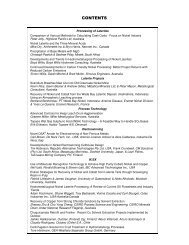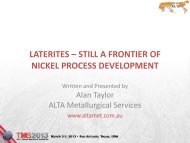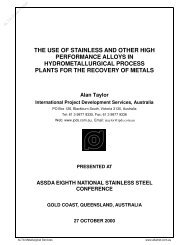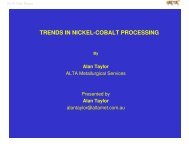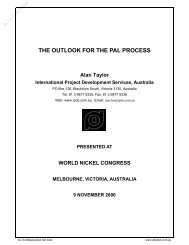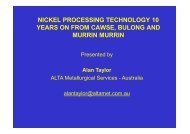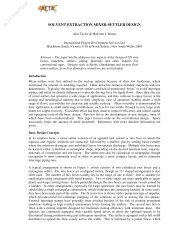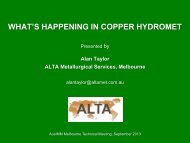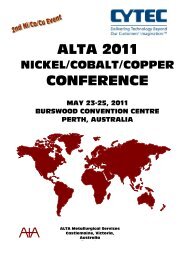review of mixer-settler types and other possible contactors for ...
review of mixer-settler types and other possible contactors for ...
review of mixer-settler types and other possible contactors for ...
Create successful ePaper yourself
Turn your PDF publications into a flip-book with our unique Google optimized e-Paper software.
ALTA Free Paper<br />
Large diameter interstage piping needed to minimize pressure drop because <strong>of</strong> limited head<br />
generated by pump-<strong>mixer</strong>s.<br />
Crud tends to collect in <strong>settler</strong>s, requiring periodic removal to avoid process upsets.<br />
Not suitable <strong>for</strong> systems with a large number <strong>of</strong> stages.<br />
2.2. KREBS MIXER-SETTLER<br />
Developed by Krebs in France in the nineteen seventies, <strong>and</strong> subsequently installed in numerous<br />
uranium <strong>and</strong> a fewer number <strong>of</strong> copper SX plants including the initial Olympic Dam operation in<br />
South Australia which came on stream in 1993. (The later expansion used conventional <strong>mixer</strong><strong>settler</strong>s<br />
<strong>for</strong> copper SX.)<br />
Like the conventional <strong>mixer</strong>-<strong>settler</strong>, there can be one or more mix boxes per stage depending on the<br />
solution flow rates <strong>and</strong> the required retention time. For a single box, the agitator is fitted with a low<br />
head, high volume, low shear conical pump, consisting <strong>of</strong> a static tulip shaped stator <strong>and</strong> a<br />
trapezoidal, typically six bladed, rotor. This is used to develop the head to lift the dispersion up to<br />
the pre-separation launder positioned above the <strong>settler</strong>. If two mix boxes are used, the first is<br />
equipped with a pump-mix type agitator, similar to the conventional <strong>mixer</strong>-<strong>settler</strong>, but designed <strong>for</strong><br />
less head generation because <strong>of</strong> the adjoining conical pump.<br />
Typically the primary separation <strong>of</strong> the organic <strong>and</strong> aqueous phases is 90% complete at the<br />
discharge <strong>of</strong> the upper launder, which enables the phases to be directed separately to the main<br />
<strong>settler</strong> below, entering via a baffle system. The organic <strong>and</strong> aqueous discharge weir boxes <strong>and</strong><br />
weirs are similar to the conventional design.<br />
Materials <strong>of</strong> construction options are similar to the conventional design. However, because <strong>of</strong> its<br />
smaller size, there is greater opportunity <strong>for</strong> shop fabrication <strong>and</strong> transport to site. The unit is totally<br />
covered to keep dust out <strong>and</strong> minimize organic evaporative losses.<br />
Fiure 2 illustrates a Krebs <strong>mixer</strong>-<strong>settler</strong> with two mix boxes, arranged <strong>for</strong> organic phase recycle<br />
Fig. 2: Krebs Mixer-Settler Elevation View<br />
Table 1 presents an economic comparison with the conventional <strong>mixer</strong>-<strong>settler</strong> taken from from<br />
‘Krebs <strong>and</strong> Solvent Extraction” by Roger Williams <strong>and</strong> Alain Sonntag presented at the ALTA<br />
Copper Hydrometallurgy Forum 1995.<br />
4



